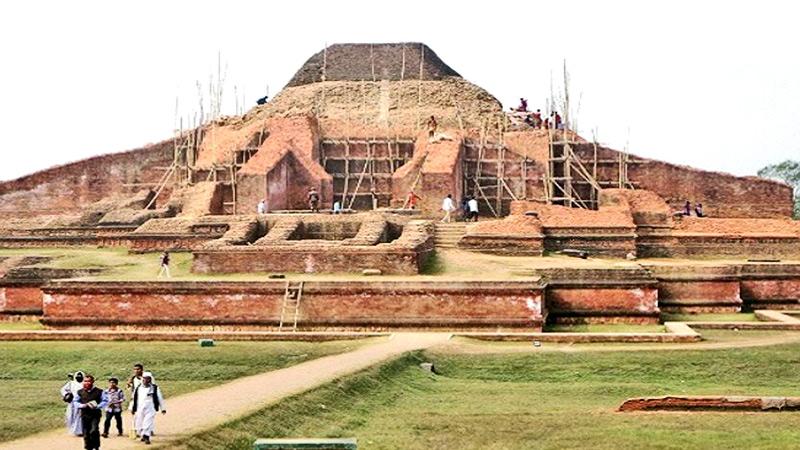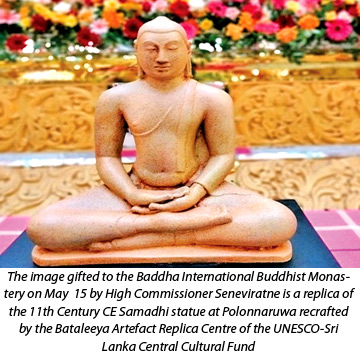
The speech delivered by Prof. Sudharshan Seneviratne, High Commissioner for Sri Lanka in Bangladesh and Ambassador Extraordinary and Plenipotentiary to the Kingdom of Bhutan to mark the Buddha Purnima on May 15, 2022 at the Baddha International Buddhist Monastery in Dhaka, Bangladesh.
 I am indeed privileged to partake in the 2022 Buddha Purnima Ceremony of Bangladesh at the Baddha International Buddhist Monastery in Dhaka. It is an event blessed by the Most Venerable Bhikkhu Sunandapriya and all venerable Sirs, in the presence of State Minister of Religious Affairs Farudul Haq Khan including Ambassadors of Thailand, Nepal and Myanmar along with the Buddhist devotees of Bangladesh and Sri Lanka. I am pleased to learn that this sacred space is also the land gifted by Her Excellency Sheik Hasina, Prime Minister of Bangladesh to the International Buddhist Monastery.
I am indeed privileged to partake in the 2022 Buddha Purnima Ceremony of Bangladesh at the Baddha International Buddhist Monastery in Dhaka. It is an event blessed by the Most Venerable Bhikkhu Sunandapriya and all venerable Sirs, in the presence of State Minister of Religious Affairs Farudul Haq Khan including Ambassadors of Thailand, Nepal and Myanmar along with the Buddhist devotees of Bangladesh and Sri Lanka. I am pleased to learn that this sacred space is also the land gifted by Her Excellency Sheik Hasina, Prime Minister of Bangladesh to the International Buddhist Monastery.
This country is blessed by a leader who follows Sheik Mujibur Rahman, Banga Bandu’s ideals of peaceful co-existence and inclusivity as the most valued contribution to human culture. Her Excellencies compassionate sentiments were amply expressed when she promptly gifted medical supplies worth US$2.3 million to Sri on this blessed month of Buddha Purnima.
Our two lands were connected through material and cultural ties dating to the 6th Century BC. The intense convergence of trade in the Bay of Bengal witnessed religio-cultural interactions between ancient Vangadesha (Bangladesh) and Tambapanni (Sri Lanka). Buddhism was the catalyst that carried the message of peace and civilisation to both lands. It endowed a rich doctrinal and cultural ethos of Theravada and Mahayana traditions enriched by a sober perception of life and civilisation in our lands. The historic material culture and the living traditions of Buddhism in Sri Lanka and Bangladesh reflect the pristine sentiments embedded in the culture of these lands.
My introduction to Bangladesh had a trajectory. First, my deep respect for Gurudev Tagore, a shared icon of our lands, and his sublime vision of humanism. Secondly, my archeo-historical studies on the history of early Buddhism, its doctrinal aspects and the higher material culture in the Northern curve of South Asia. Thirdly, prior to my arrival, the blessings I received from resident Bangladesh student Buddhist bhikkus in Sri Lanka. It was indeed a convergence of history and blessings welcoming me to this land and its people in the most auspicious manner.
I was born into a culture nurtured by Buddha’s sublime thoughts on compassion, tolerance, equality, inclusiveness, and the development of a humane personality. His thoughts also unfolded a dynamic culture and the intellectual ethos that moved from subcontinental to transcontinental spaces. We are gathered here today not only to revere the memory of a compassionate and intellectual sage but also to look at ourselves in the light of peace, harmony, and co-existence as a universal truth juxtaposed to injustice, conflict, discrimination, and discord.
Universal message
I wish to take this opportunity to share some thoughts on Buddhism and humanism which is a universal message that is valued by the people of our two lands.

The success story of historical Buddhism was its flexibility to intervene and engage itself, both, compassionately and intellectually at all levels in society. Its functional value is found not purely in its doctrinal aspects per se but also in the realm of inclusiveness embracing all living beings and the universe with loving-kindness, and understanding without discrimination.
The Buddha equated knowledge or wisdom with the truth. Buddhism itself was recognised as the “doctrine of analysis” or vibajja-vada. Knowledge leading to the truth could not be imposed from above but be realised through an uninhibited spirit of critical inquiry as pronounced in the Kalama sutta. Those who seek knowledge were instructed to break away from the four extremes or fetters: bias (chanda), prejudice (dosha), fear (bhaya), and delusion (moha). This is freedom of thought and action at its best.
Buddhism also introduced the earliest conscious effort at people-to-people connectivity. The message of knowledge and peace was disseminated to society by the Order of monks (bhikkhu) and nuns (bhikknin). The clergy constituted themselves as a democratic and egalitarian collective. Individual lay members (upasaka and upasika), who joined the order, had to renounce their social identity, rank and status. No one was discriminated against based on preexisting social or rank status in the Order, which was pristine as water from different rivers taste of salt in one ocean. Buddha explicitly denounced social discrimination and pronounced the value of equality where a person’s social status was gauged not by birth and material wealth, but on ethical conduct and moral behaviour (Vasala sutta).
Buddhism was a response to the realities of a society transforming itself from a simple village culture to a complex and impersonal urban and state society. These realities manifested themselves in the form of conflict, hegemonic behaviour, contradictions, competition and marginalisation. According to the Agganna sutta preached by the Buddha, it is greed and forcible removal of wealth owned by others that originally resulted in social tension and conflict in the world.
The effort to secure economic and territorial hegemony often unleashed destructive confrontations between kingdoms at that time. It was also a society that indulged itself in extreme forms of either sensual pleasures or self- mortification. Discontentment, oppression and insecurity underlined the realities of social existence in the Middle Gangetic valley at that time. The same narrative is not uncommon in the present world. As against the two extremes, the Buddha prescribed the middle path or majjima magga.
The Buddha neutralised social and a person tension at several levels. One of the earliest social contracts for conflict resolution may be found again in the Agganna sutta. It describes the community, oppressed by conflict, elected an individual to settle disputes. He was Mahasammata or the “great elect”. Mahasammata was expected to maintain peace through laws of righteousness, good governance, accountability and transparency.
There are other suttas recording Ten Righteous Obligations or Dasa raja Dhamma prescribed to the Universal King. He was responsible not only for good and just governance but also to protect the total environment of the domain as his moral obligation to maintain quality of life.
Buddhist ethics
In Buddhist ethics - society, environment and habitat are synonymous. The sacred tree of enlightenment of the Buddhists or Ficus Religiosa, symbolically represents the protected biosphere for our own sustainable existence.
The Buddha’s original pronouncement to the first disciples was “to wander far and near for the benefit of the people out of compassion…” They were also instructed to communicate with the local people in the vernacular (Prakrit). This negated the power of an exclusive and hegemonic sacred language of communication.
People to people connectivity were further enhanced by the absorption of local folklore (Jataka narratives) as stories of morality for a life of righteousness and spirituality. The code of ethical conduct inscribed in the five precepts (pancha-siila) upheld individual accountability to society for a life of morality minimising tension and conflict.
The transcontinental movement of the Buddha’s word spread as a peaceful dynamic of absorption, adoption, adaption, and accommodation. It not only conveyed the spirit of the doctrine but also a higher culture represented in social norms of co-existence, ethical behaviour, language and script, art forms, and architecture. Buddhist monasteries were not only places of worship and social convergence but were expressive centers of excellence for intellectual and cultural activity representing a high culture featured in art and architecture.
By the first millennium CE, such centers were found and flourished at Taxila, Nalanda, Anuradhapura, Odantapuri and Vikaramashila including Paharpur Maiamati, and Jagaddala in Bangladesh. Buddhism indeed was a doctrine of the intellect and higher culture that went beyond borders and transcended language, cultural, and even religious barriers. The Buddhist culture was truly international in character.
Today we constantly face questions about the social and environmental cost of aggressive political encroachments, material development, and globalisation and its “imagined development” resulting in untold damage to lives, enforced discrimination dismantling the social and moral fabric of the world. Conversely, humanising social, economic, and cultural interactions within a sustainable environment is seen as an alternative to development imposed from above on unequal partners in the global world. The Buddha’s message for peace and co-existence is based on reaching out to all living beings with loving-kindness, accommodation, and understanding thus underlining its importance to society as a timeless universal message.
Devo vassatu kalena
(May there be rains at the right season)
Sassasampatti hotu ca
(May there be a plentiful harvest)
Pito bhavatu lokoca
(May all people be happy)
Raja bhavatu dammiko
(May rulers govern with righteousness)!
May all be blessed with metta (loving kindness), karuna (compassion), mudita (sympathetic joy) and upekkha (equanimity).
